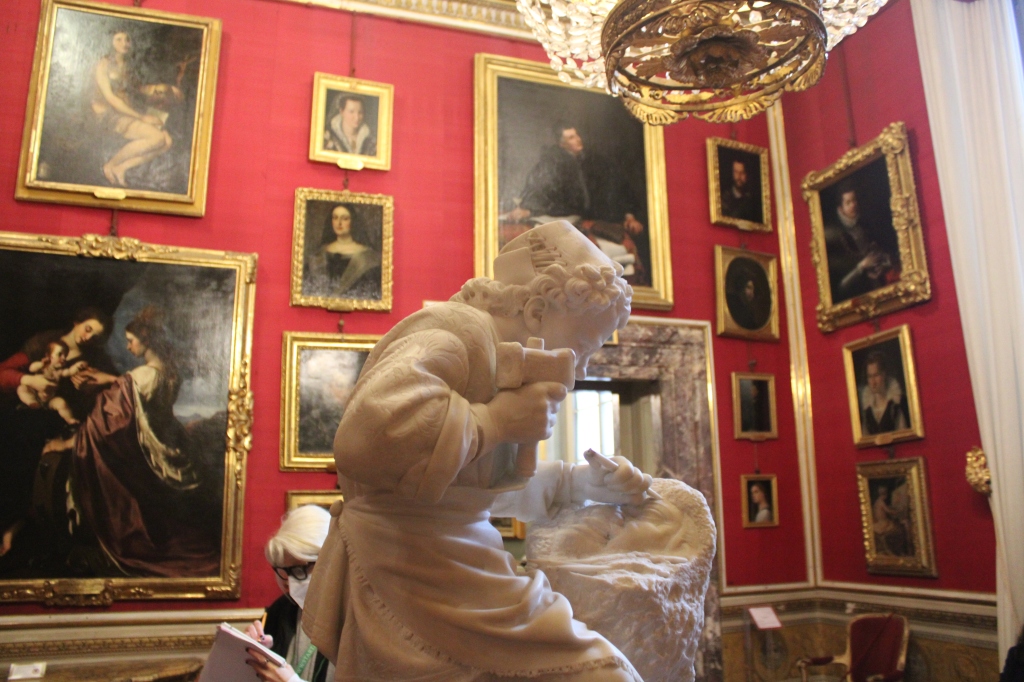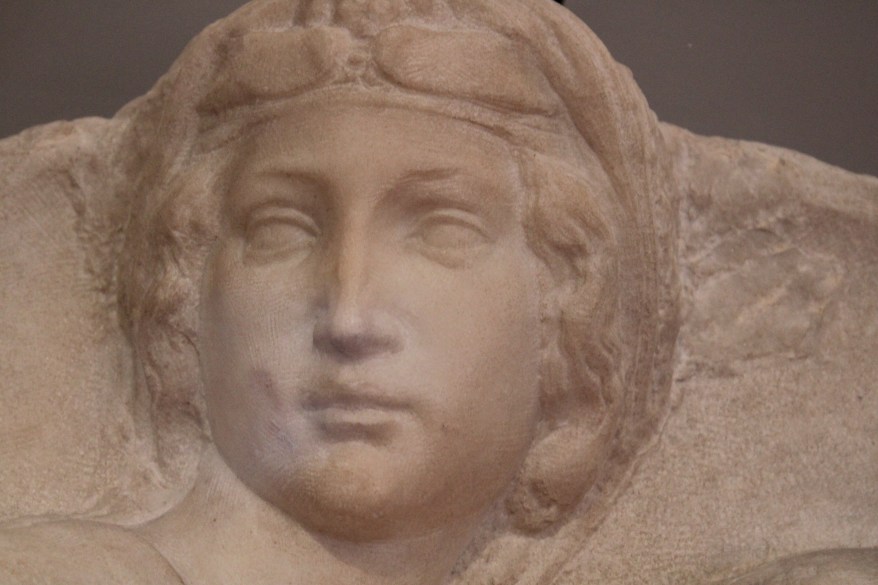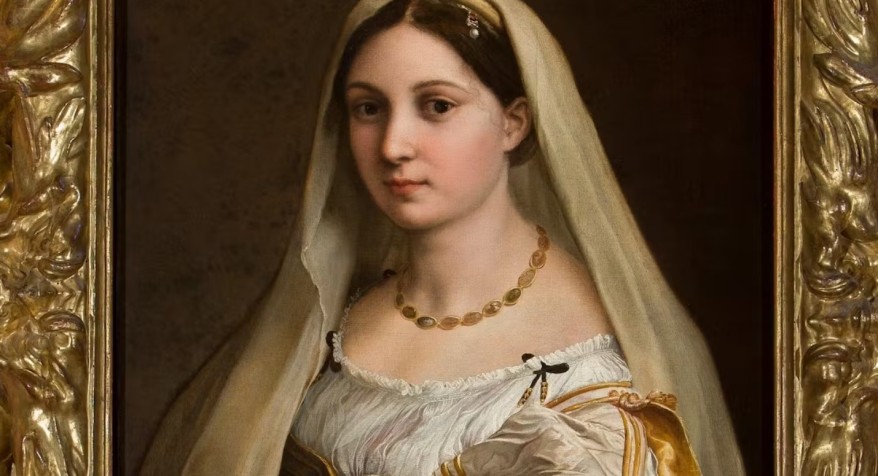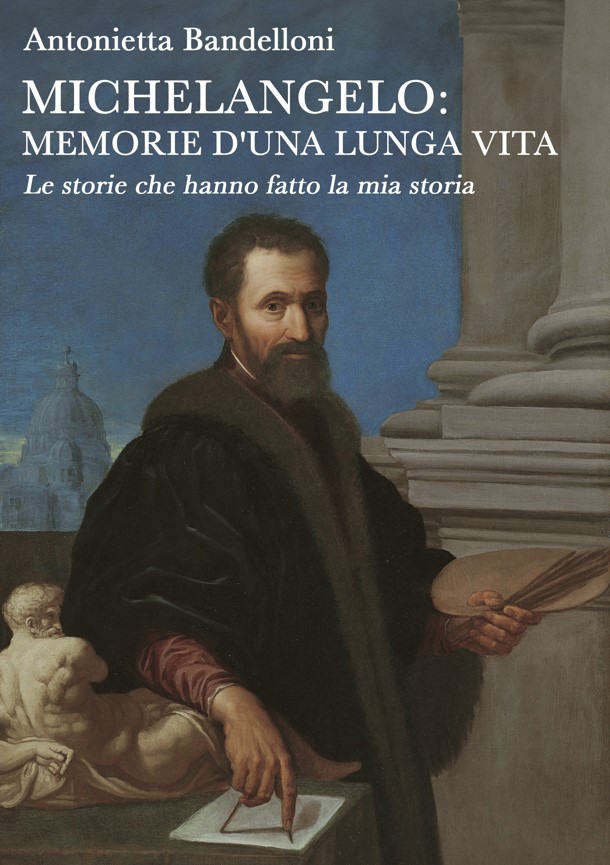Il Michelangelo Fanciullo di Emilio Zocchi
Visitando a Galleria Palatina di Palazzo Pitti, vi ritroverete faccia a faccia con un me ragazzino alle prese con la scultura del mascherone del Fauno, opera oggi data per perduta.
Quel candido marmo che mi ritrae fu scolpito da Emilio Zocchi, noto scultore fiorentino che ebbe modo di imparare i rudimenti del mestiere da Giovanni Dupré.
L’opera si trova al centro della Sala delle Allegorie e mi mostra con scalpello e martello fra le mani, concentrato nello scolpire quel vecchio fauno che poi il Magnifico mi fece notare che per l’età raggiunta non potesse avere ancora in bocca tutti quei denti.
In quel periodo avevo tredici anni.
Con una bella veste damascata e un grembiule di cuoio allacciato in vita, siedo sopra ciò che rimane di un’antica colonna che fa anche da supporto alla testa in lavorazione. La colonna allude allo studio attento delle opere antiche, fondamentale per i giovani che come me nel Rinascimento si avvicinavano al mondo dell’arte.
La pomposità dell’abito poco aveva a che fare con le vesti assai più modeste che mi mettevo di solito. Ve lo immaginate come mi sarei conciato a scolpire con quel prezioso vestito? Schegge e polvere di marmo ovunque non avrebbero reso un buon servizio a un tessuto tanto prezioso. Diciamo che l’artista che mi scolpì si prese una licenza poetica nell’inventarsi gli abiti da mettermi addosso.
Se osservate bene ai miei piedi compare lo scudo con le sei palle della famiglia Medici che in quel periodo della mia giovinezza mi aveva accolto a casa propria per permettermi di studiare scultura nella prima accademia ante litteram: il Giardino di San Marco.
Il Magnifico, durante la mia permanenza nel Giardino dei giovani talenti, mi ospitò a casa sua e così ebbi modo di conoscere letterati, filosofi e tutti coloro che frequentavano abitualmente la mensa di Lorenzo de’ Medici.
Dell’artista Cesare Zocchi è apprezzabile la resa degli abiti che mi volle far indossare e quella degli accessori. Senza dubbio si ispirò alle vesti tutt’oggi visibili nel dipinti del Quattrocento e del Cinquecento. Basta pensare ai raffinati tessuti sfoggiati dai personaggi del Corteo dei Magi dipinto da Benozzo Gozzoli a Palazzo Medici Riccardi per rendersene conto.
Il realismo dei dettagli più minuti come le frange del grembiule, la parte concava nella testa del martello in ferro dolce causato dall’abituale utilizzo, le pieghe dei calzari e i motivi che decorano la veste non lasciano stupefatti solo gli osservatori di oggi ma conquistarono il re Vittorio Emanuele II.
Il monarca volle comprare l’opera nel 1862 per decorare i propri appartamenti di Palazzo Pitti e da allora il me bambino scolpito da Zocchi, ancora si trova fra le sue sale.
Di quest’opera ne esistono tante copie realizzate sempre da Zocchi. Si pensa che siano circa un centinaio ma ne esistono altrettante con lo stesso soggetto con variazioni più o meno evidenti realizzate da artisti differenti, persino da suo cugino Cesare Zocchi.
Nel 1865 Emilio Zocchi volle partecipare con una replica di questo lavoro all’esposizione internazionale di Dublino dove fu acquistata subito mentre nel 1870 un’altra versione fu portata alla mostra italiana di belle arti di Parma e poi all’esposizione universale di Vienna nel 1873.
Per il momento il vostro Michelangelo Buonarroti vi saluta dandovi appuntamento ai prossimi post e sui social.
The Child Michelangelo by Emilio Zocchi
Visiting the Palatine Gallery of Palazzo Pitti, you will find yourself face to face with a little boy grappling with the sculpture of the mask of the Faun, a work now considered lost.
That candid marble that portrays me was sculpted by Emilio Zocchi, a well-known Florentine sculptor who was able to learn the rudiments of the trade from Giovanni Dupré.
The work is in the center of the Hall of Allegories and shows me with chisel and hammer in my hands, concentrated on sculpting that old faun who the Magnificent then pointed out to me that due to his age he could not still have all those teeth in his mouth .
I was thirteen at the time.
With a beautiful damask dress and a leather apron tied at the waist, I sit on what remains of an ancient column that also serves as a support for the working head. The column alludes to the careful study of ancient works, essential for young people who like me in the Renaissance approached the world of art.
The pomposity of the dress had little to do with the much more modest clothes I usually wore. Can you imagine how I would have tanned sculpting with that precious dress? Splinters and marble dust everywhere would not have done such a precious fabric a good service. Let’s say that the artist who sculpted me took poetic license in inventing the clothes to wear.
If you look closely at my feet, the shield with the six balls of the Medici family appears, which in that period of my youth had welcomed me into their home to allow me to study sculpture in the first ante litteram academy: the Garden of San Marco.
During my stay in the Garden of Young Talents, the Magnificent hosted me in his home and thus I had the opportunity to meet men of letters, philosophers and all those who habitually frequented Lorenzo de’ Medici’s canteen.
The rendering of the clothes that he wanted me to wear and that of the accessories is appreciable by the artist Cesare Zocchi. Undoubtedly he was inspired by the garments still visible today in the paintings of the fifteenth and sixteenth centuries. Just think of the refined fabrics sported by the characters in the Procession of the Magi painted by Benozzo Gozzoli at Palazzo Medici Riccardi to realize this.
The realism of the smallest details such as the fringes of the apron, the concave part in the head of the soft iron hammer caused by habitual use, the folds of the shoes and the motifs that decorate the dress not only amaze today’s observers but conquered the king Victor Emmanuel II.
The monarch wanted to buy the work in 1862 to decorate his apartments in Palazzo Pitti and since then the child me sculpted by Zocchi can still be found in his rooms.
There are many copies of this work, also made by Zocchi. It is thought that there are about a hundred but there are just as many with the same subject with more or less evident variations created by different artists, even by his cousin Cesare Zocchi.
In 1865 Emilio Zocchi wanted to participate with a replica of this work in the international exhibition in Dublin where it was immediately purchased while in 1870 another version was taken to the Italian exhibition of fine arts in Parma and then to the universal exhibition in Vienna in 1873.
For the moment, your Michelangelo Buonarroti greets you by making an appointment for the next posts and on social media.

Sostienici – Support Us
Se questo blog ti piace e ti appassiona, puoi aiutarci a farlo crescere sempre più sostenendoci in modo concreto condividendo i post, seguendo le pagine social e con un contributo che ci aiuta ad andare avanti con il nostro lavoro di divulgazione. . ENGLISH: If you like and are passionate about this blog, you can help us make it grow more and more by supporting us in a concrete way by sharing posts, following social pages and with a contribution that helps us to move forward with our dissemination work.
5,00 €
-
La Velata di Raffaello: la sua opulenza e quel gioiello fra i capelli, dalla parte del cuore
🇮🇹Il dipinto del giorno che vi propongo oggi è la Velata Raffaello, il capolavoro dell’artista urbinate realizzato attorno al 1515. Vi siete mai domandati che significato abbia il gioiello che porta sul capo?… 🇬🇧The painting of the day that I propose to you today is the Velata Raffaello, the masterpiece of the artist from Urbino…
-
Alberto Angela torna a Pompei
Alberto Angela torna a Pompei per raccontare al grande pubblico le nuove scoperte fatte dagli archeologi negli ultimi mesi…
















